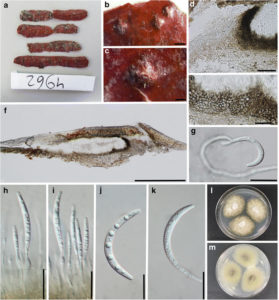Cryptosporella alni-cordatae W.J. Li, Qing Tian, Camporesi & K.D. Hyde, sp. nov., MycoBank number: MB 820839.
Etymology: In reference to the host genus.
Saprobic on dead stems of Alnus cordata (Betulaceae). Sexual morph Undetermined. Asexual morph Coelomycetous. Conidiomata 1055–1500 μm diam. × 207–375 μm high, pycnidial, dark brown to black, solitary to gregarious, deeply immersed, becoming erumpent at maturity, subglobose, unilocular, glabrous, thick-walled, lacking an ostiole but dehiscing by an irregular split in the apical wall. Conidiomata wall 20–180 μm wide, composed of relatively thick-walled, brown to black cells of textura angularis at the sides, and thick-walled, brown cells of textura angularis at the base. Conidiophores reduced to conidiogenous cells. Conidiogenous cells 15–31 μm long, 2–5 μm wide, hyaline, enteroblastic, phialidic, cylindrical to lageniform, broaden towards upper part, determinate, smooth, thick-walled, formed from inner layers of conidioma. Conidia 40.5–72 × 4.6–7.7 μm (x̅ = 59 × 6 μm, n = 30), hyaline, fusiform to lunate, rounded at apex, slightly truncate and narrowed at base, curved, aseptate, thick-walled, smooth-walled, guttulate.
Culture characteristics: Colonies on PDA, white to olivaceous, flattened, with filamentous, sparse, aerial hyphae on the surface, circular at margin, entire to crenate, reaching 30 mm diam. after 14 d at 25–30 °C, reverse brown to olivaceous.
Material examined: ITALY, Ravenna [RA]), Zattaglia, on dead stem of Alnus cordata(Betulaceae), 23 March 2016, Erio Camporesi, IT-2964 (MFLU 16–0812, holotype), living culture, MFLUCC 16–0485, ICMP. ibid. (KUN! HKAS 96362, isotype).
Notes: Most Cryptosporella species occur on Betulaceae (Alnus, Betula, and Corylus), especially on some species of Alnus, and appear to be host-specific. Cryptosporella amistadensis has only been recorded on A. acuminata in Argentina and Panama, C. jaklitschii on A. serrulata, and C. marylandica on A. maritima, whereas C. suffuse colonized more than five species of Alnus(Reid and Booth 1987; Mejía et al. 2008), C. multicontinentalis is associated with three species of Alnus in Europe and North America, C. alni-rubrae on A. rubra and C. alni-tenuifolia on A. incana subsp. tenuifolia, C. alni-sinuatae on A. viridis subsp. sinuata in the Pacific Northwest (USA), and C. femoralis on A. incana subsp. rugosa in eastern North America. However, no Cryptosporella species have been reported from A. cordata. Cryptosporella alni-cordatae is resolved herein based on morphology and multigene DNA data (ITS, TEF-1α, and LSU) and represents a distinct species with 80% ML and 0.97 PP support. It forms a sister group to C. multicontinentalis (host: Alnus incana ssp. rugose and A. glutinosa), C. suffusa (host: A. incana), and C. pacifica (host: A. incana and A. viridis), which all clustered in a distinct clade. These taxa are distinguished based on their unique host and multigene phylogenetic data.
Fig. Cryptosporella alni-cordatae (holotype). a Herbarium specimen, stems of Alnus cordata. b, c Appearance of conidiomata on the host surface. d, e Vertical section through peridium. f Vertical section through conidiomata. g Germinating conidium on PDA after 12 h. h, i Conidiogenous cells and developing conidia. j, k Conidia. l, mCultures on PDA. Scale bars: b = 200 μm, c = 500 μm, d = 50 μm, e, h–k = 20 μm, f = 500 μm, g = 50 μm.

